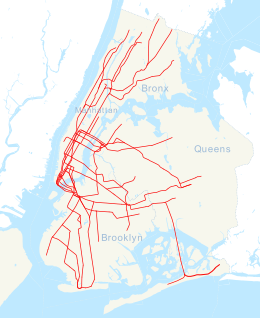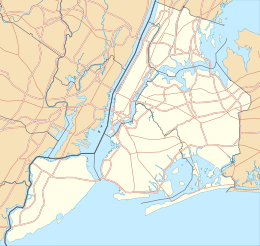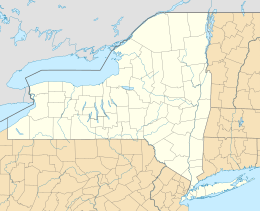Bay Parkway station (BMT West End Line) facts for kids
Quick facts for kids
Bay Parkway
|
|||||||
|---|---|---|---|---|---|---|---|

Platforms prior to renovations
|
|||||||
| Station statistics | |||||||
| Address | Bay Parkway & 86th Street Brooklyn, NY 11214 |
||||||
| Borough | Brooklyn | ||||||
| Locale | Bensonhurst, Bath Beach | ||||||
| Coordinates | 40°36′10″N 73°59′39″W / 40.602655°N 73.994293°W | ||||||
| Division | B (BMT) | ||||||
| Line | BMT West End Line | ||||||
| Services | D alltimes (all times) | ||||||
| Transit connections | |||||||
| Structure | Elevated | ||||||
| Platforms | 2 island platforms cross-platform interchange |
||||||
| Tracks | 3 (2 in regular service) | ||||||
| Other information | |||||||
| Opened | July 29, 1916 | ||||||
| Station code | 068 | ||||||
| Accessible | |||||||
| Opposite-direction transfer available | Yes | ||||||
| Former/other names | Bay Parkway–22nd Avenue | ||||||
| Traffic | |||||||
| Passengers (2019) | 2,446,673 |
||||||
| Rank | 196 out of 425 | ||||||
| Station succession | |||||||
| Next north | 62nd Street (express): no regular service 20th Avenue (local): D alltimes |
||||||
| Next south | 25th Avenue (local): D alltimes Coney Island–Stillwell Avenue (express): no regular service |
||||||
|
|||||||
|
|||||||
|
|||||||
|
|
|||||||
|
Bay Parkway Station (Dual System BRT)
|
|||||||
| MPS | New York City Subway System MPS | ||||||
| NRHP reference No. | 05000670 | ||||||
| Added to NRHP | July 6, 2005 | ||||||
Bay Parkway is a subway station in Brooklyn, New York City. It's part of the BMT West End Line and is located where Bay Parkway meets 86th Street in the Bensonhurst neighborhood. The station is served by the D train all the time. It used to be called "Bay Parkway–22nd Avenue."
Contents
History of Bay Parkway Station
How the Station Was Built
Bay Parkway station first opened on July 29, 1916. It was part of an extension of the BMT West End Line. This line originally started as a surface railway in 1862. It was called the Brooklyn, Bath and Coney Island Railroad.
Later, in 1913, a big project called the Dual Contracts helped build elevated (above-ground) tracks. These new tracks replaced the old railway that ran on the street. This made the subway system bigger and better.
Platform Upgrades and Accessibility
In the 1950s, the station's platforms were made longer. This was done so they could fit the longer subway trains used today. These trains are about 615 feet (187 meters) long.
More recently, in 2012, the station got a major upgrade. Three new elevators were added, making it easier for everyone to use the station. One elevator goes from each platform down to the ticket area. Another elevator goes from the ticket area down to the street. These improvements were paid for with money from a special government program.
Station Layout and Design
Understanding the Station Platforms
The Bay Parkway station is an elevated station, meaning it's high above the street. It has two island platforms. An island platform is like an island in the middle, with train tracks on both sides. There are also three tracks in total, but only two are used regularly for trains. The middle track is usually not used for passenger service.
Both platforms have brown roofs, called canopies, with green frames. They also have wooden benches where you can sit. You'll see station signs and lampposts along the platforms. At the south end of the station, there's a special building called a signal tower. This tower helps control the train signals.
The M Train at Bay Parkway
From 1987 to 2010, the M train used to end its journey here during busy times. Even though signs might have suggested the M train used the middle express track, it actually used the local tracks. This is because there weren't any special switches north of the station to let trains move to the express track. South of the platforms, there were special track crossings that allowed M trains to turn around or wait before heading back towards Manhattan.
Historic Landmark Status
The station's structure was built with concrete over steel. Because of its unique design and history, the Bay Parkway station was added to the National Register of Historic Places on July 6, 2005. This means it's recognized as an important historical site.
Station Exits
The station has one main building below the tracks, which is made of metal and has concrete floors. From each platform, two staircases lead down to a waiting area. Here, you'll find turnstiles, which are gates that let you enter or exit the station after paying your fare. There's also a ticket booth where you can buy tickets or get help.
Outside the paid area, four staircases lead down to the street. These stairs are located at all four corners of the intersection of Bay Parkway and 86th Street. The station building used to have windows on all sides, but most of them are now covered.
Gallery
- nycsubway.org – BMT West End Line: Bay Parkway
- Station Reporter — D Train
See also
 In Spanish: Bay Parkway (línea West End) para niños
In Spanish: Bay Parkway (línea West End) para niños










